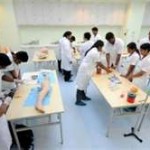Don't miss
- Two Thanksgiving Thoughts for the ACAPosted 10 years ago
- Shop til you Drop at the Healthcare Marketplace Part 2: Frustration!Posted 10 years ago
- An Early Casualty in the Affordable Care FightPosted 10 years ago
- Some Good News for a ChangePosted 10 years ago
Bedside Manners by Dr. Krikor Deramerian
By Tom Godfrey on March 18, 2012
After the posting of Bedside Manner, I had a very thoughtful exchange with a former colleague of mine and I asked him if he would collect his thoughts and expand them for the Post. The result is the quite wonderful piece that follows. Krikor Deramerian is a pediatrician practicing in Southern California with the Southern California Permanente Medical Group. TG
 Bedside is the place where medical care is provided. The manner by which this is done defines the art of medicine. Bedside manner has come to represent the culture of medicine. What actually takes place at the bedside, the interaction of the patient and physician, is a fascinating event.
Bedside is the place where medical care is provided. The manner by which this is done defines the art of medicine. Bedside manner has come to represent the culture of medicine. What actually takes place at the bedside, the interaction of the patient and physician, is a fascinating event.
The physician arrives at the bedside after a long journey. That journey is of paramount importance to understand for the patient and the physician. Most college students, usually with a science background, enter medical school professing the desire to help others through the skills of medical science. This student knowingly, through a disorder of delayed gratification, dedicates four years of their youth while others may get married and/or begin engaging life in its fullness. After medical school, having acquired immense amount of knowledge through day and night studying, not to mention financial debt, choose the particular means by which to practice medicine. This will culminate in life-depriving and sleep-depriving endeavor of residency – often called cheap or slave labor.
During the years of residency, the student, now a physician, devotes him/herself to learn the application of medicine. S/he sees the pathology and outcomes of illness, researching and learning the best means to identify the cause and then treat it. This becomes a preoccupation that defines their profession and lives, despite  aforementioned hardships. Having developed these skills, they graduate residency with the most current state of the art medical knowledge, with pride and eagerness in possessing the ability to make a difference.
aforementioned hardships. Having developed these skills, they graduate residency with the most current state of the art medical knowledge, with pride and eagerness in possessing the ability to make a difference.
The patient arrives at the “bed” through a journey that is equally important to understand. A patient presents with a concern that is in need of acknowledgment, reassurance and improvement. Well… at least some effort at it. We are all engaged in our daily lives, meeting our responsibilities, expectations and working toward what brings pleasure and happiness to our lives. This can be, in terms of family, work, hobbies, beliefs and personal achievement. For all these, we need to be healthy.
 When there is a disruption or impediment, it can be frightening. Hence we seek help. In seeking help, we become a patient. A patient brings to bear all that they have – as an individual, or the family, having preconceived notions, beliefs, anxieties, experiences and unique culture. There is nothing uniform, structured or objective. There is no science.
When there is a disruption or impediment, it can be frightening. Hence we seek help. In seeking help, we become a patient. A patient brings to bear all that they have – as an individual, or the family, having preconceived notions, beliefs, anxieties, experiences and unique culture. There is nothing uniform, structured or objective. There is no science.
The task of bedside manners is to bring to bear the passion of the resident tempered by respect and empathy toward the complete patient. This is not only critical to the humanity of medicine, but also crucial to good clinical skills. To establish trust by the patient there needs to be a sense of acknowledgement. Only then will the physician be able to obtain information necessary for an accurate diagnosis. The interaction here is engaged in gestures, tone, body language and empathy. This same trust will be necessary to effectively implement the treatment that is needed. The science of medicine is a tool that is administered through a caring and understanding touch. A physician may not be able to cure all ailments or condition, but at least they can give a sense of caring.
 That is bedside manners, and that is the art of medicine. The Golden Rule (Do onto others as you would have done onto yourself) does not apply. A physician must seek the Platinum Rule – Do onto others as they would wish to be applied onto themselves. As simple as it may seem, physicians often lose sight of who the visit is about. It is about the patient. Understanding not just what the disease is, but how it is affecting the person. This empathy is what medical schools look for. A person can be taught medicine, they cannot be taught caring. As physicians, we are often limited. We may be limited by what we can offer and what the patient is willing to accept. In both cases, it is important to maintain a caring, understanding and supportive role.
That is bedside manners, and that is the art of medicine. The Golden Rule (Do onto others as you would have done onto yourself) does not apply. A physician must seek the Platinum Rule – Do onto others as they would wish to be applied onto themselves. As simple as it may seem, physicians often lose sight of who the visit is about. It is about the patient. Understanding not just what the disease is, but how it is affecting the person. This empathy is what medical schools look for. A person can be taught medicine, they cannot be taught caring. As physicians, we are often limited. We may be limited by what we can offer and what the patient is willing to accept. In both cases, it is important to maintain a caring, understanding and supportive role.
This piece speaks well for itself and its author. The best doctors are those who are continually thinking about their own art of medicine and bedside manners. Tom Godfrey







